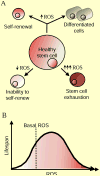ROS function in redox signaling and oxidative stress
- PMID: 24845678
- PMCID: PMC4055301
- DOI: 10.1016/j.cub.2014.03.034
ROS function in redox signaling and oxidative stress
Abstract
Oxidative stress refers to elevated intracellular levels of reactive oxygen species (ROS) that cause damage to lipids, proteins and DNA. Oxidative stress has been linked to a myriad of pathologies. However, elevated ROS also act as signaling molecules in the maintenance of physiological functions--a process termed redox biology. In this review we discuss the two faces of ROS--redox biology and oxidative stress--and their contribution to both physiological and pathological conditions. Redox biology involves a small increase in ROS levels that activates signaling pathways to initiate biological processes, while oxidative stress denotes high levels of ROS that result in damage to DNA, protein or lipids. Thus, the response to ROS displays hormesis, given that the opposite effect is observed at low levels compared with that seen at high levels. Here, we argue that redox biology, rather than oxidative stress, underlies physiological and pathological conditions.
Copyright © 2014 Elsevier Ltd. All rights reserved.
Figures





References
-
- Cross CE, Halliwell B, Borish ET, Pryor WA, Ames BN, Saul RL, McCord JM, Harman D. Oxygen radicals and human disease. Annals of internal medicine. 1987;107:526–545. - PubMed
-
- Wood ZA, Poole LB, Karplus PA. Peroxiredoxin evolution and the regulation of hydrogen peroxide signaling. Science. 2003;300:650–653. - PubMed
-
- Rhee S. Cell signaling. H2O2, a necessary evil for cell signaling. Science. 2006;312:1882–1883. - PubMed
Publication types
MeSH terms
Substances
Grants and funding
LinkOut - more resources
Full Text Sources
Other Literature Sources
Medical

